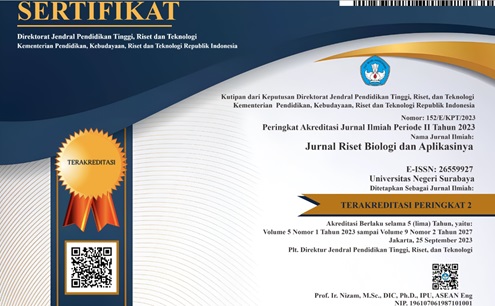In Silico Evaluation of rbcL, matK, and psbA-trnH Regions on the Genus Spatholobus (Fabaceae)
DOI:
https://doi.org/10.26740/jrba.v6n2.p73-81Abstract
Spatholobus is a genus that belongs to the Fabaceae that is known to contain various bioactive compounds and distributed across Asia, including Indonesia. However, exploration of Spatholobus in Indonesia is still rare. Therefore, DNA barcoding is used to support the exploration and conservation of Spatholobus in Indonesia. However, there is no universal marker that can be used across all plant species. In addition, there are still few studies related to DNA barcoding within the genus Spatholobus. The purpose of this study was to evaluate the rbcL, matK, and intergenic spacer psbA-trnH regions in silico that can be used as DNA barcodes for the genus Spatholobus. This study began with a sequence search on the NCBI database including the rbcL, matK, and intergenic spacer psbA-trnH genes in the genus Spatholobus and Phaseolus coccineus as the outgroup. Each sequence was then aligned with ClustalW. Then, a phylogenetic tree was constructed using the Maximum-Likelihood (ML) with 1000× bootstrap. As a result, the rbcL, matK, and psbA-trnH regions can be used as markers for DNA barcoding in the genus Spatholobus with different specifications. The rbcL and matK can be used to distinguish Spatholobus at the genus level, while the psbA-trnH can be used to distinguish Spatholobus at the species level.
References
Anzani, A. N., Martiansyah, I., & Yuliani, N. (2021). Studi In Silico DNA Barcoding Pada Bunga Soka (Ixora). Prosiding Biologi Achieving the Sustainable Development Goals with Biodiversity in Confronting Climate Change, 7(1), 168-177. https://doi.org/10.24252/psb.v7i1.23693
Handayani, H., Setia,T. M. (2021). Konservasi Genetika Badak Sumatera di Indonesia. Bio-Sains, 1(1), 19-25. https://doi.org/10.34005/bio-sains.v1i1.1566
Hanifa, Y. R., Pujiyanto, S., Ferniah, R. S., & Kusumaningrum, H. P. (2021). Identifikasi Molekuler Jeruk Nipis Tegal Berdasarkan Fragmen Gen 18s Ribosomal RNA. Jurnal Bioteknologi & Biosains Indonesia, 8(2), 244-254. https://ejurnal.bppt.go.id/index.php/JBBI/article/view/4883/4188
Hasna, L. Z., Sehkhaemi, P., & Aviciena, M. A. (2022). Review: Akar Kayu Bajakah dan Manfaatnya untuk Kesehatan. FoodTech: Jurnal Teknologi Pangan, 4(1), 32-39. http://dx.doi.org/10.26418/jft.v4i1.56637
Hollingsworth, P. M., Graham, S. W., Little, D. P. (2011). Choosing and Using a Plant DNA Barcode. PLoS ONE, 6(5), e19254. https://doi.org/10.1371/journal.pone.0019254
Husin, C. N. C., Naim, D. M., Ahmad M. I. (2018). Authentication of a selected medicinal plants using DNA barcoding technique. SHS Web of Conference, 45, 05004. https://doi.org/10.1051/shsconf/20184505004
Kalangi, C., Kamu, V. S., Kumaunang, M. (2014). Barcode DNA Tanaman Leilem (Clerodendrum minahassae L.) Berdasarkan Gen matK. Jurnal MIPA UNSTRAT Online, 3(2), 108-112. https://doi.org/10.35799/jm.3.2.2014.5861
Kumar, S., Stecher, G., Li, M., Knyaz, C., & Tamura, K. (2018). MEGA X: Molecular Evolutionary Genetics Analysis across computing platforms. Molecular Biology and Evolution, 35(6), 1547-1549. https://doi.org/10.1093/molbev/msy096
Letsiou, S., Madesis, P., Vasdekis, E., Montemurro, C., Grigoriou, M. E., Skavdis, G., Moussis, V., Koutelidakis, A. E., & Tzakos, A. G. (2024). DNA Barcoding as a Plant Identification Method. Applied Sciences, 14(4), 1415. https://doi.org/10.3390/app14041415
Li, X., Yang, Y., Henry, R. J., Rossetto, M., Wang, Y., & Chen, S. (2014). Plant DNA barcoding: from gene to genome. Biological Reviews, 90(1), 157-166. https://doi.org/10.1111/brv.12104
Mahfut., Daryono, B. S., Indrianto, A., & Sumowiyarjo, S. (2019). Plant-Virus Interaction on Orchids Infected Odontoglossum ringspot virus (ORSV) in Bogor Botanical Garden, Indonesia. International Conference on Science Technology, (May). http://dx.doi.org/10.4108/eai.2-5-2019.2284701
Nderitu, K. W., Ager, E., Mecha, E., & Nyachieo, A. (2023). DNA Barcoding Using ITS2 and rbcL Markers for Solanaceae Species Identification. East African Medical Journal, 100(1), 5567-5574. https://www.ajol.info/index.php/eamj/article/view/242644
Nei, M. & Kumar, S. (2000). Molecular Evolution and Phylogenetics. Oxford University Press.
POWO. (2024). Spatholobus Hassk. Accessed through: Plants of The World Online at: https://powo.science.kew.org/.
Prasetyorini, B. E., Kusumawardani, A., Fitriani, F., Oktriana, P., Amelinda, N., & Ramadhani, A. N. (2022). Analisis In Silico Senyawa Aktif Batang Kayu Bajakah (Spatholobus Littoralis Hassk) Sebagai Terapi Psoriasis. Herb Medicine Journal, 5(1), 26-35. http://dx.doi.org/10.30595/hmj.v5i2.12744
Pratiwi, A., Kinasih, A., Meidianing, M. I., Kurniawan, F. Y., Semiarti, E. (2023). In Silico Approach for DNA Barcoding using Phylogenetic Analysis of Coelogyne spp. based on the matK, rpoC1, rbcL and nrDNA Markers. Journal of Tropical Biodiversity and Biotechnology, 8(3), 1-14. https://doi.org/10.22146/jtbb.73130
Rahayu, D. A., Nugroho, E. D., & Listyorini, D. (2019). DNA barcoding ikan introduksi khas Telaga Sari, Kabupaten Pasuruan. Biotropika: Journal of Tropical Biology, 7(2), 51-62. https://doi.org/10.21776/ub.biotropika.2019.007.02.2
Rousdy, D. W., & Wardoyo, E. R. P. (2023). In Vitro Antiinflammatory Activity of Bajakah (Spatholobus littoralis) Stem Extract. Biosaintifika: Journal of Biology & Biology Education, 15(2), 150-157. https://doi.org/10.15294/biosaintifika.v15i2.36227
Sen, L., Fares, M. A., Liang, B., Gao, L., Wang, B., Wang, T., & Su, Y. J. (2011). Molecular Evolution Of rbcL In Three Gymnosperm Families: Identifying Adaptive And Coevolutionary Patterns. Biology Direct, 6(29). https://doi.org/10.1186/1745-6150-6-29
Suesatpanit, T., Osathanunkul, K., Madesis, P., & Osathanunkul, M. (2017). Should DNA sequence be incorporated with other taxonomical data for routine identifying of plant species? BMC Complementarty and Alternative Medicine, 17, 437. https://doi.org/10.1186/s12906-017-1937-3
Sumarlina, & Napitupulu, T. S. (2023). Evaluasi Aplikasi DNA Barcode Lokus psbA-trnH pada Genus Momordica. Jurnal Biotek, 11(2), 182-195. https://doi.org/10.24252/jb.v11i2.37914
Suprasanna, P., Mirajkar, S. J., & Bhagwat, S. G. (2015). Induced Mutation and Crop Improvement, Plant Biology and Biotechnology: Plant Diversity, Organization, Function and Improvement. Springer.
Turhadi, & Hakim, L. (2023). Evaluasi Lokus Kloroplas untuk DNA Barcoding pada Marga Stelechocarpus (Annonaceae) Secara In-Silico. Agro Bali: Agricultural Journal, 6(1), 56-64. https://doi.org/10.37637/ab.v6i1.1105
Wardah, & Sundari, S. (2019). Ethnobotany Study of Dayak Society Medicinal Plants Utilization in Uut Murung District, Murung Raya Regency, Central Kalimantan. IOP Conference Series: Earth and Environmental Science. 298, 012005.
https://iopscience.iop.org/article/10.1088/1755-1315/298/1/012005
Yeni, L. F., Kamelia, N., & Chaerani. (2023). Antibacterial Potential of West Kalimantan Local Bajakah (Spatholobus suberectus) Ethanol Extract against Micrococcus luteus. Quagga: Jurnal Pendidikan dan Biologi, 15(2), 193-200. https://doi.org/10.25134/quagga.v15i2.27
Downloads
Published
How to Cite
Issue
Section
License
Copyright (c) 2024 Jurnal Riset Biologi dan Aplikasinya

This work is licensed under a Creative Commons Attribution-NonCommercial 4.0 International License.
 Abstract views: 483
,
Abstract views: 483
, PDF Downloads: 413
PDF Downloads: 413












